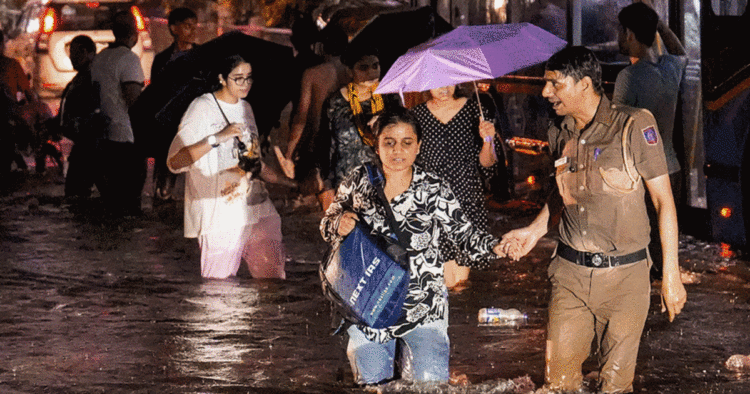Since Wednesday evening, intense monsoon rains have led to severe flooding and landslides across seven states in India, resulting in the deaths of at least 32 people. The relentless downpour has created chaos in Delhi-NCR, Uttarakhand, Himachal Pradesh, and several other regions.
Delhi-NCR Hit Hard
Delhi and its surrounding areas experienced a record-breaking single-day rainfall of 108 mm on Wednesday, the highest for July in 14 years. This deluge caused significant flooding in the city, disrupting traffic and leading to the collapse of walls in some areas. Several underpasses were submerged, severely affecting transportation routes to Noida, Gurugram, Faridabad, and Ghaziabad.
In Uttarakhand and Himachal Pradesh, heavy rains triggered cloudbursts that resulted in at least 14 fatalities. The situation remains dire, with many individuals still unaccounted for. The Indian Meteorological Department (IMD) has forecasted more rain for these states over the next five days, complicating rescue efforts.
Kerala’s Wayanad district has been devastated by massive landslides triggered by continuous rain. The death toll in this region has risen to 256, with numerous people still missing.
Rescue operations, supported by the Indian Army, are ongoing. The army has managed to rescue nearly 1,000 people, but 220 remain unaccounted for. Kerala Chief Minister Pinarayi Vijayan has announced that those rescued will be temporarily housed in camps, with rehabilitation plans underway.
Other States Experience Fatal Rainfall
In Greater Noida and Gurugram, two people have died, while Jaipur in Rajasthan has reported three deaths due to drowning when rainwater flooded a basement. Additionally, Bihar has seen five fatalities from lightning strikes. Chief Minister Nitish Kumar has expressed condolences and promised financial aid to the victims’ families.
The Dachan area of Kishtwar in Jammu and Kashmir has also suffered from flash floods and cloudbursts, causing damage to infrastructure like bridges and buildings. Rivers in the Rajouri district are overflowing, leading to severe waterlogging in roads.
ALSO READ: “Wayanad Landslides: Death Toll Rises To 256”
Overall Rainfall Statistics and Predictions
The IMD reported that July saw a 9% increase in rainfall compared to the normal average, with central India receiving 33% more rain. Looking ahead, the IMD predicts above-normal rainfall for August and September, with the likelihood of favorable La Nina conditions by the end of August. The current rainfall across India stands at 453.8 mm since June 1, 2% above the expected amount.
The affected states are bracing for more heavy rain until August 7, with no immediate relief in sight. The situation remains critical, with rescue operations continuing and efforts underway to provide aid to those impacted by the severe weather.

















Comments